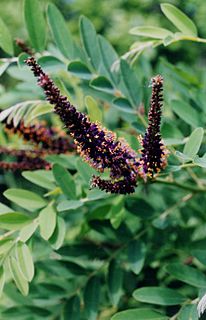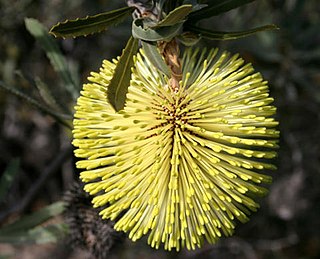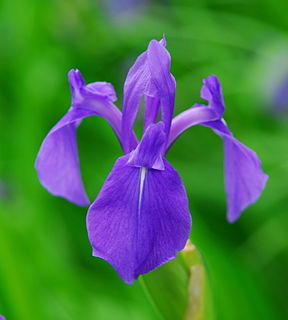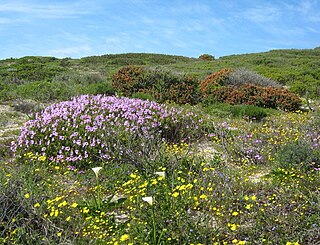
Rosa laevigata, the Cherokee rose, is a white, fragrant rose native to southern China and Taiwan south to Laos and Vietnam, and invasive in the United States.

Crataegus monogyna, known as common hawthorn, oneseed hawthorn, or single-seeded hawthorn, is a species of flowering plant in the rose family Rosaceae. It is native to Europe, northwest Africa and West Asia but has been introduced in many other parts of the world.

Amorpha is a genus of plants in the pea family, Fabaceae. All the species are native to North America, from southern Canada, most of the United States (US), and northern Mexico. They are commonly known as false indigo. The name Amorpha means "deformed" or "without form" in Greek and was given because flowers of this genus only have one petal, unlike the usual "pea-shaped" flowers of the Faboideae subfamily. Amorpha is missing the wing and keel petals.

Banksia rosserae is a recently described species of Banksia. Endemic to inland Western Australia, it is the only Banksia species to occur solely within the arid zone.

Crataegus laevigata, known as the midland hawthorn, English hawthorn, woodland hawthorn or mayflower, is a species of hawthorn native to western and central Europe, from Great Britain and Spain east to the Czech Republic and Hungary. It is also present in North Africa. The species name is sometimes spelt C. levigata, but the original orthography is C. lævigata.

Banksia laevigata, commonly known as the tennis ball banksia, is a species of shrub that is endemic to Western Australia. It has serrated, broadly linear to narrow wedge-shaped leaves, yellow or yellowish green flowers, depending on subspecies, and linear to elliptic follicles with a slightly wrinkled surface.

Celtis laevigata is a medium-sized tree native to North America. Common names include sugarberry, Southern hackberry, or in the southern U.S. sugar hackberry or just hackberry.

Banksia ser. Cyrtostylis is a taxonomic series within the plant genus Banksia. First published at sectional rank by George Bentham in 1870, it was demoted to a series by Alex George in 1981. The name has had three circumscriptions.
Kevin Thiele and Pauline Ladiges taxonomic arrangement of Banksia, published in 1996, was a novel taxonomic arrangement that was intended to align the taxonomy of Banksia more closely with the phylogeny that they had inferred from their cladistic analysis of the genus. It replaced Alex George's 1981 arrangement, but most aspects were not accepted by George, and it was soon replaced by a 1999 revision of George's arrangement. However some herbaria have continued to follow Thiele and Ladiges on some points.

Alex George's taxonomic arrangement of Banksia was the first modern-day arrangement for that genus. First published in 1981 in the classic monograph The genus Banksia L.f. (Proteaceae), it superseded the arrangement of George Bentham, which had stood for over a hundred years. It was overturned in 1996 by Kevin Thiele and Pauline Ladiges, but restored by George in 1999. A recent publication by Austin Mast and Kevin Thiele suggests that it will soon be overturned again.

Echinacea laevigata, the smooth purple coneflower, is an Endangered Species Act federally listed endangered species of plant found in the piedmont of the eastern United States. Most populations are found on roadsides and other open areas with plenty of sunlight, often on calcium- and magnesium- rich soils.

Banksia laevigata subsp. laevigata, the tennis ball banksia, is a subspecies of small woody shrub in the plant genus Banksia. It occurs in Western Australia's semi-arid shrubland. It and the closely related B. laevigata subsp. fuscolutea are the two subspecies of the species Banksia laevigata.

Banksia ser. Ochraceae is a valid botanic name for a taxonomic series within the plant genus Banksia. It was published by Kevin Thiele in 1996, but discarded by Alex George in 1999.

Iris laevigata, known as Japanese iris, rabbit-ear iris, or shallow-flowered iris, is a species of flowering plant in the family Iridaceae, native to Japan. It is related to other members of Iris subgenus Limniris, including other species of Japanese irises.

Banksia laevigata subsp. fuscolutea is a subspecies of Banksia laevigata. It is native to the Southwest Botanical Province of Western Australia.

Biscutella laevigata, the buckler-mustard, is a species of flowering plant in the family Brassicaceae.

Cape Flats Dune Strandveld is an endangered vegetation type. This is a unique type of Cape Strandveld that is endemic to the coastal areas around Cape Town, including the Cape Flats.

Aureolaria levigata, commonly known as entireleaf yellow false foxglove or Appalachian oak-leech, is a species of flowering plant in the family Orobanchaceae. It is native to much of the Appalachian Mountains and surrounding areas in the eastern United States. It is also found in a disjunct population in southwestern Mississippi.

Periploca laevigata is a species of flowering plant in the family Apocynaceae, native to the Canary Islands, the Savage Islands and Cape Verde.

Androsace laevigata, synonym Douglasia laevigata, known as the cliff dwarf primrose, is a species of flowering plant in the primrose family, Primulaceae. It is native to the central Pacific coastal mountains of North America below 2,400 metres (8,000 ft) elevation. Its habitat includes cliffs, rocks, and alpine.


















